Page 187 of 356
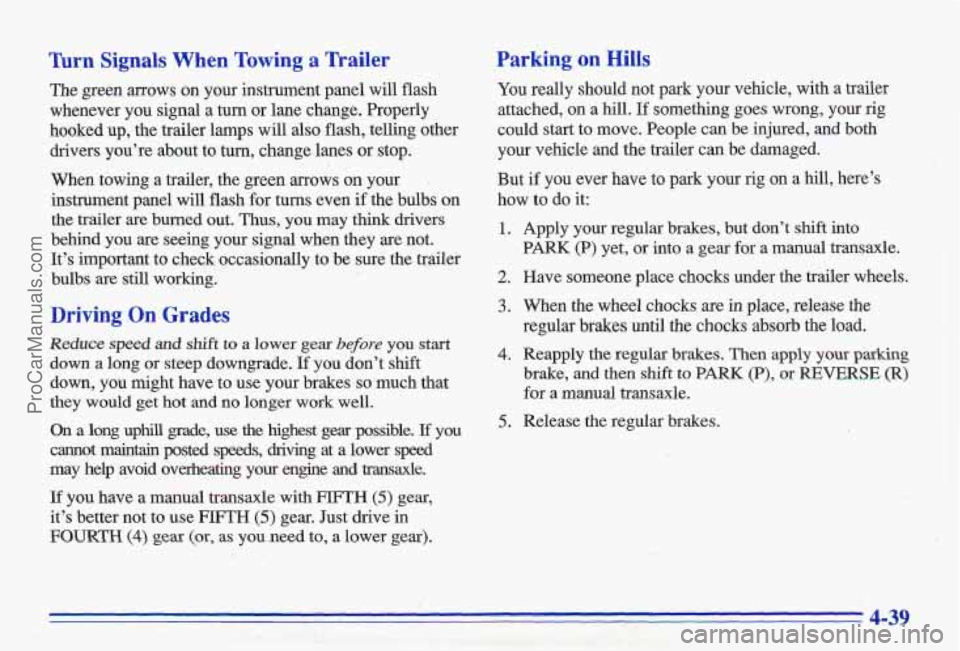
Turn Signals When Towing a Trailer
The green arrows on your instrument panel will flash
whenever you signal a turn or lane change. Properly
hooked up, the trailer lamps
will also flash, telling other
drivers you’re about to
turn, change lanes or stop.
When towing a trailer, the green arrows
on your ’.
instrument panel will flash for turns even if the bulbs on
the trailer are burned out. Thus, you may think drivers
behind you are seeing your signal when they are not.
It’s important to check occasionally to be sure the trailer
bulbs are still working.
Driving On Grades
Reduce speed and shift to a lower gear before you start
down a long or steep downgrade. If you don’t shift
down, you might have to use your brakes
so much that
they would
get hot and no longer work well.
On a long uphill grade, use the highest gear possible. If you
cannot maintain posted speeds, driving at a lower speed
may help avoid overheating your engine and bxmsaxle.
If you have a manual transaxle with FWTH (5) gear,
it’s better not to use
FIFTH (5) gear. Just drive in
FOURTH (4) gear (or- as vou need to, a lower gear).
Parking on Hills
You really should not park your vehicle, with a trailer
attached, on a
hill. If something goes wrong, your rig
could start to move. People can be injured, and both
your vehicle and the trailer can be damaged.
But if you ever have to park your rig on a hill, here’s
how to
do it:
1.
2.
3.
4.
5.
Apply your regular brakes, but don’t shift into
PARK (P) yet, or into a gear for a manual transaxle.
Have someone place chocks under the trailer wheels. When the wheel chocks are in place, release the
regular brakes until the chocks absorb
the load.
Reapply the regular brakes. Then apply your
parking
brake, and then shift to PARK (P), or REVERSE (R)
for a manual transaxle.
Release the regular brakes.
4-39
ProCarManuals.com
Page 188 of 356
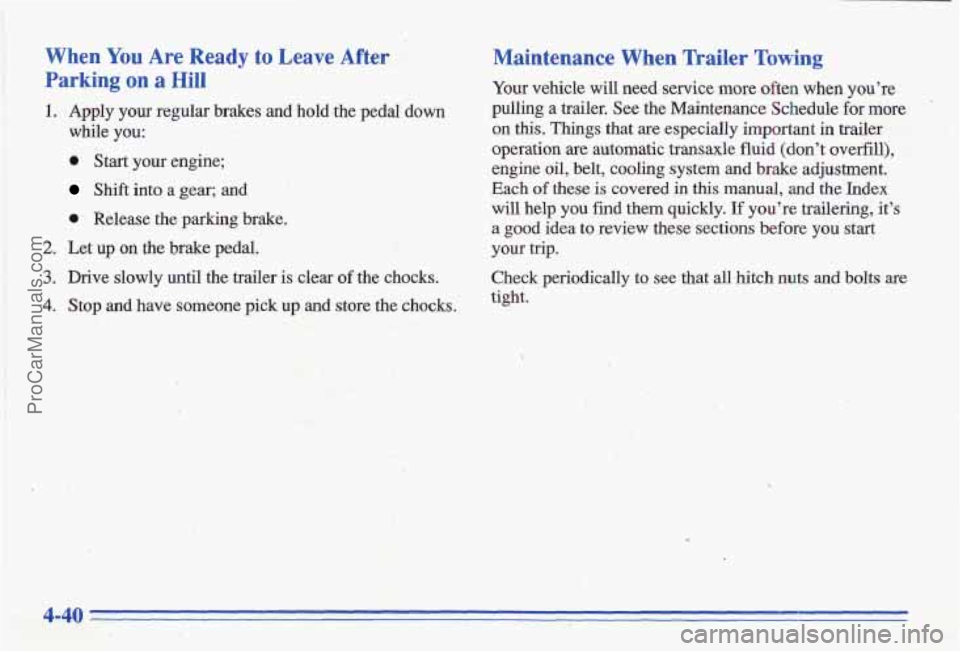
When You Are Ready to Leave After
Parking on a Hill
1. Apply your regular brakes and hold,the pedal down
while
you:
0 Start your engine;
Shift into a gear; and
I. Release the parking brake.
2. Let up on the brake pedal..
3. Drive slowly until the trailer is clear of the chocks.
4. Stop and have someone pick up and store the chocks.
Maintenance When Trailer Towing
Your vehicle will need service more often when you're
pulling a trailer. See the Maintenance Schedule for more
on this. Things that are especially important in trailer
operation are automatic transaxle
fluid (don't ovel-fill),
engine oil, belt, cooling system and brake adjustment.
Each of these is covered in this manual, and the Index
will
help you find them quickly. If you're trailering, it's
a good idea to review these sections before you start
<* ~ I ,,; ;-':'. .a t , ,--: .. ;::l.$.:$ 5
Check periodically to see that all hitch nuts and bolts are
tight.
your trip. ! . .i . :$ ,,- .,,. . . f ~
_I.,
4-40
ProCarManuals.com
Page 193 of 356
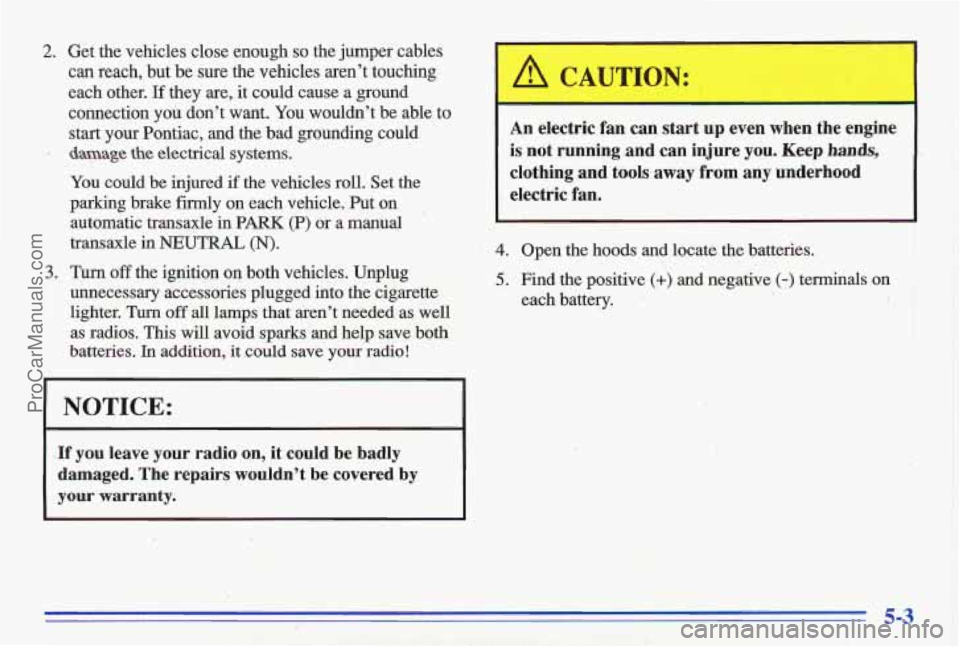
2. Get the vehicles close enough so the jumper cables
can reach, but be sure the vehicles aren’t touching
each other.
If they are, it could cause a ground
connection
you don’t want. You woulddt be able to
start your Pontiac, and the bad grounding could
You could be injured if the vehicles roll. Set the
parking brake firrnly on each vehicle. Put on automatic transaxle in
PARK (P) or a manual
transaxle
in NEUTRAL (N).
1 damage the electrical systems.
3. Turn off the ignition on both vehicles. Unplug
unnecessary accessories plugged into the cigarette lighter.
Turn off all lamps that aren’t needed as well
as radios. This will avoid sparks and help save both
batteries. In addition,
it could save your radio!
I NOTICE:
.If you leave your radio on, it could be badly
damaged. The repairs wouldn’t be covered
by
your warranty.
An electric fan can start up even when the engine
is not running and can injure
you. Keep hands,
clothing and tools.away from any underhood electric fan.
4. Open the hoods and locate the batteries.
5. Find the positive (+) and negative (-) terminals on
each battery.
5-3
ProCarManuals.com
Page 194 of 356
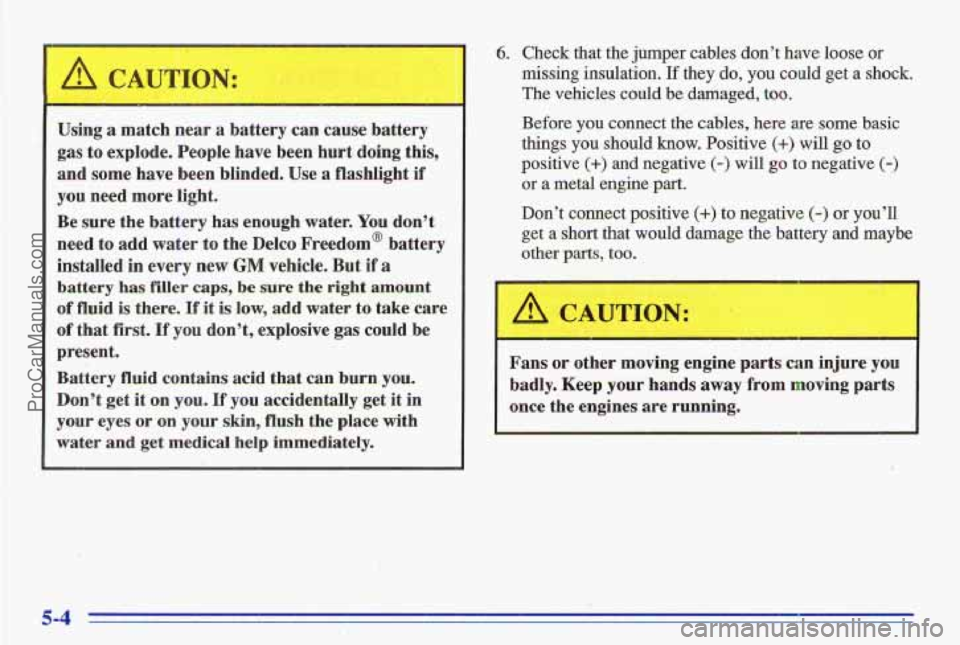
6. Check that the jumper cables don’t have loose or
missing insulation, If they do, you could get a shock.
The vehicles could be damaged,
too.
Before you connect the cables, here are some basic
things you should
know. Positive (+) will go to
positive (+) and negative (-) will go to negative (-)
or a metal engine part.
Don’t connect positive (+) to negative (-) or you’ll
get a short that would damage the battery and maybe
other
parts, too.
Using
a match
near a battery can cause battery
gas to explode. People have been hurt doing this,
and some have been blinded. Use
a flashlight if
you need more light.
~ Be sure the battery has enough water. You don’t
need to add water
to the Delco Freedom@ battery
installed in every new
GM vehicle. But if a
battery has filler caps, be sure the right amount
of fluid is there. If it is low, add water to take care
of that first. If you don’t, explosive gas could be
present.
Battery fluid contains acid that can burn
you.
Don’t get it on you. If you accidentally get it in
your eyes or on your skin, flush the place with
water and get medical help immediately. Fans
or other moving engine
parts can injure you
badly. Keep your hands away from moving parts
once the engines are running.
5-4
ProCarManuals.com
Page 195 of 356
Use a remote positive (+) terminal if the vehicle has
one.
8. Don’t let the other end
touch metal. Connect it
to the positive
(+)
terminal of the good
battery.
Use a remote
positive
(+) terminal
if the vehicle has one.
7. Connect the red positive (+) cable to the positive (+)
terminal of the vehicle with the dead battery.
II
9. Now connect the
black negative
(-)
I cable to the good q;<2: &?:I battery’s negative (-)
terminal.
Don’t let the other end
touch anything until the next
step. The other end
of the negative cable doesn’t go to
the dead battery.
It goes to a heavy unpainted metal part
on the engine of the vehicle with the dead battery.
5-5
ProCarManuals.com
Page 196 of 356
10. Attach the cable at least 18 inches (45 cm) away
from the dead battery, but not near engine pasts that
move. The electrical connection is just as good
there, but the chance of sparks getting back to the
battery
is much less.
the engine for a while.
11. Now start the vehicle with the good battery and run
12. Try to start the vehicle with the dead battery.
If it won’t start after a few tries, it probably needs
service.
13. Remove the cables in reverse order to prevent
electrical shorting.
Take care that they don’t touch
each other or
any other metal.
A. Heavy Metal Engine Part
B. Good Battery
C. Dead Battery
-
5-6
ProCarManuals.com
Page 202 of 356
Engine Overheating .
You will find a coolant temperature g.age and a low
coolant warning light on your Pontiac’s instrument
panel. See
“Engine Coolant Temperature Gage” and
“Low Coolant Warning Light” in the Index.
If Steam Is Coming From Your Engine
Steam from an overheated engine can burn you
badly, even if you just open the hood. Stay away
from the engine if you
see or hear steam coming
~ from it. Just turn it off and get everyone away
from the vehicle until it cools down. Wait until
there
is no sign of steam or coolant before
opening the
hood,
If you keep driving when your engine is
overheated, the liquids in it can catch fire, You or
others could
be badly burned. Stop your engine if
it overheats, and get out of the vehicle until the
engine is cool.
1 NOTICE:
~ ~~
If your engine catches fire because you keep
driving with no coolant, your vehicle can be
badly damaged. The costly repairs would not be
covered by your warranty.
5-12
ProCarManuals.com
Page 203 of 356
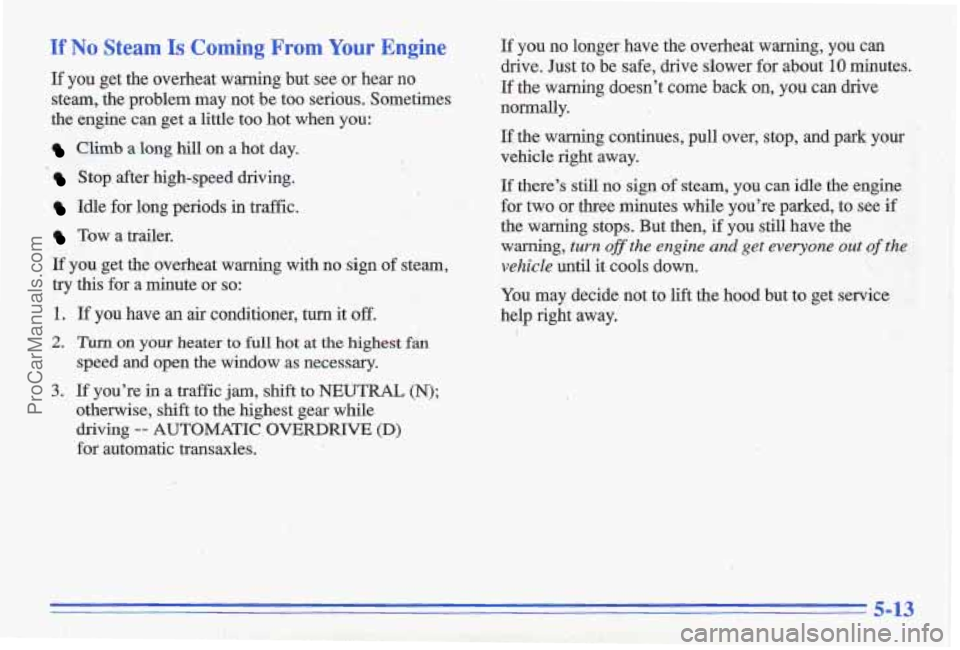
If No Steam Is Coming From Your Engine
If you get the overheat warning but see or hear no
steam, the problem may not b'e too serious. Sometimes
the engine can get a little too hot when you:
Cbb a long hill on a hot day.
' Stop after high-speed driving.
Idle for long periods in traffic.
Tow a trailer.
If you get the overheat warning with no sign of steam,
try this for a minute or so:
1. If you have an air conditioner, turn it off.
2. Turn on your heater to full hot at the highest fan
speed and open the window as necessary.
3. If you're in a traffic jam, shift to NEUTRAL (N);
otherwise, shift to the highest gear while
driving
-- AUTOMATIC OVERDRIVE (D)
for automatic transaxles. ;+, 1; , !, -.,.r., . .-I? ,*:, I,3 : 1 I' ' . . :4?,+ . .I .
If you no longer have the overheat warning, you can
drive. Just to be safe, drive slower for about 10 minutes.
If the warning doesn't come back on, you can drive
normally.
If the warning continues, pull over, stop, and park your
vehicle right away.
If there's still no sign of steam, you can idle the engine
for two or three minutes while you're parked, to see
if
the warning stops. But then, if you still have the
warning,
turn ojf the engine and get everyone out of the
vehicle
until it cools down.
You may decide not .to lift the hood but to get service
help right 'away.
5-13
ProCarManuals.com